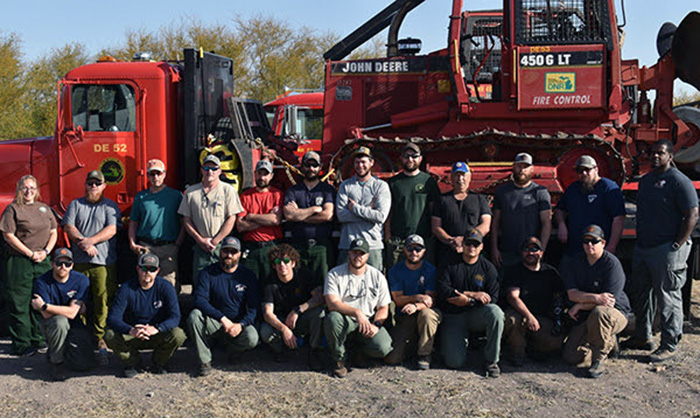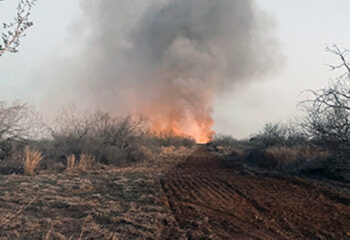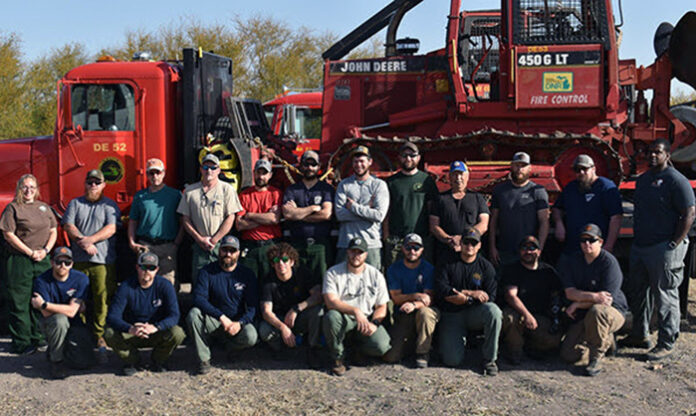
MICHIGAN – While many parts of the Upper Peninsula were still covered in snow, wildfire season was already raging in southern Texas.
Corey Mallory was one of several wildland firefighters from the Michigan Department of Natural Resources who took their skills – and specially equipped bulldozers – to Texas to help stamp out wildfires on grassy plains and in mesquite thickets turned into tinder by severe drought.
Their mission: Help any way you can, anywhere you can.
That might mean standing guard at a local post, assisting local firefighters on wind-blown fires or using the bulldozer to create a strip of bare earth between an advancing fire and the grass it consumes as fuel.
Every day in that situation is just kind of a guess to see how it will go,” said Mallory, a seven-year fire veteran who works out of the DNR’s Shingleton office.
Mallory is one of a team of DNR firefighters who took on a total of 69 out-of-state assignments this fire season, which runs roughly from March through November, depending on location. They’ve traveled as far west as Arizona, California and Oregon and as close to home as southern Ohio.
“Western assignments can help people become more well-rounded as firefighters,” said Mallory, who also completed a fall assignment in Washington state. “You learn different tactics, different types of fuel and topography.”
Jeff Stampfly, chief of the DNR’s Forest Resources Division, has served some out-of-state assignments in the past, too.
“We have a long tradition of helping other states in need,” he said. “This is a way to keep skills sharp while protecting people and property.”
Michigan is fully reimbursed for the firefighters’ time and travel while they are on out-of-state assignments, which typically last for two weeks with no days off.
Some of the assignments involve frontline firefighters such as Mallory. Other DNR staffers use their skills in organizing, planning, map-making, public information or even finance to make sure those on the line have everything they need to get the job done as safely and quickly as possible.
People and supplies: Here, there and everywhere
Logistics is where Scott Throop has found his niche. Throop, a forester based in Cadillac, also is trained and certified as a firefighter, with 20 years of experience.
These days he handles logistics. Throop’s most recent assignment, in September, took him to the Kootenai River Complex Fire, in the Idaho panhandle near the Canadian border.
“We’re in charge of moving stuff, feeding people and bedding them down,” Throop said. “We make sure that whatever the fire needs, we provide. The logistics section is typically the first to get up in the morning and the last to go to bed.”
The challenges are varied and unique.

On the Caldor Fire near South Lake Tahoe in fall 2021, the logistics team had to evacuate the firefighters’ tent city. Thanks to hungry wildlife in search of snacks stored in the tents while the firefighters worked, the team needed to shuttle the firefighters to alternative lodging.
“We had 300 people camping at a ski resort on the edge of town. We had to put them in hotels because every day we had bears ripping people’s tents apart,” he said.
Throop said he enjoys the challenge of getting firefighters the right tools in the right places within a reasonable time.
“When I get up in the morning, I know that I have a job to do, and I know that I can do that job very well,” Throop said. “And by me doing that job well, I can make somebody else’s job easier.”
On the scene in Arizona
Glenn Palmgren, a DNR fire management specialist based in Lansing, did two out-of-state assignments this year, at the Contreras Fire in Arizona and at the Kootenai River Complex Fire in Idaho.
He’s a leader in the planning section on a national incident management team.
The planning team manages information technology and documentation for fires, creates action plans each day and is responsible for mapping the fire and progress made toward suppressing it.
A primary concern is to keep people safe, as well as safeguarding cities, towns and important landmarks. For example, the Contreras Fire threatened the Kitt Peak Observatory, a mountainside complex 55 miles southwest of Tucson.
Opened in 1958, the observatory allows astronomers to study the heavens with two radio-controlled telescopes and a collection of other large telescopes.
The fire started with a lightning strike on June 11 and eventually encompassed more than 29,000 acres.
Staffers were evacuated from Kitt Peak on June 15, and four support buildings surrounding the huge telescopes on the site were destroyed. However, astronomers were back in business earlier this fall.
“While the loss of a few structures was unfortunate, the hard work of the firefighters and incident management team paid off in the end by saving all the critical infrastructure at the observatory and having no injuries or loss of life,” Palmgren said. “We definitely saw that as a big win.”
Texas-sized tasks
Some of Mallory’s work in Texas took place on the massive King Ranch, established in 1853 and famed for its cattle, its quarter horses and its size: 825,000 acres, an area slightly larger than the state of Rhode Island.
“It’s a different experience to work with the ranch and to fight fires on private property,” Mallory said. “Much of Texas is private land. Everywhere we went it seemed like there was a fence or a gate or a boundary.”
The Michigan team worked with local fire departments as well as Texas A&M University and U.S. Department of Agriculture’s Forest Service firefighters.
Bulldozers are a key tool in fighting fires on grasslands. Once they create a line down to bare earth, fire engines can come in and burn remaining grass up to the line or use water to suppress the fire.
“We worked on quite a few fires,” Mallory said. “Even the small fires moved relatively fast.”
The firefighters came home after 14 days to prepare for Michigan’s fire season. Spring is the most dangerous because trees are not yet green from winter dormancy and grasses have been drying out through the winter.
Not just fire …
While fire is by far their biggest responsibility, Michigan DNR wildland fire staff also have been called in recent years to help on other types of disasters, ranging from big-city pandemic operations to floods and tornadoes.
For example, in October, a DNR incident management team went to Menominee to help other agencies handle a long-burning fire at a large paper mill.
DNR staff also assisted in setup of a COVID-19 pandemic hospital at the TCF Center (now Huntington Center) in downtown Detroit. Crews also helped mobilize a mass vaccination effort at Ford Field in Detroit in 2021.
“Our training in managing wildfires also applies to many other events, and there are a lot of ways we can be of service,” Throop said.
No matter where they perform these critical jobs – here at home or lending a hand across the country – Michigan’s wildland fire program staff put every ounce of experience, commitment and heart on the line.
And most of them wouldn’t have it any other way.


